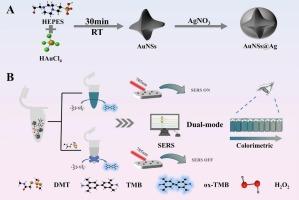AuNSs@Ag Nanoprobe-based dual-mode sensor for rapid and sensitive detection of dimethoate
IF 4.6
2区 化学
Q1 SPECTROSCOPY
Spectrochimica Acta Part A: Molecular and Biomolecular Spectroscopy
Pub Date : 2025-09-20
DOI:10.1016/j.saa.2025.126972
引用次数: 0
Abstract
Dimethoate (DMT), an organophosphate pesticide, is extensively employed in agriculture for pest management, however its persistent residues raise critical concerns regarding human health and environmental safety, necessitating the development of reliable quantification methods for residual monitoring. The sensor utilizes silver-coated gold nanostructures (AuNSs@Ag), which possess bimetallic properties and intrinsic peroxidase-like activity, to catalyze the H2O2-mediated oxidation of 3,3′,5,5′-tetramethylbenzidine (TMB). This reaction results in the formation of a blue oxidation product (ox-TMB), producing a distinct colorimetric signal. Simultaneously, this reaction generates a characteristic SERS fingerprint spectrum of ox-TMB. However, upon the introduction of DMT, competitive adsorption occurs between DMT and TMB for the active sites on the surface of AuNSs@Ag, resulting in a reduction of the reactive sites on AuNSs@Ag and a decrease in its peroxidase-like activity. Consequently, the formation of ox-TMB is reduced, leading to a diminished transition from the colorless to the blue state, as well as a weakened SERS signal. Therefore, this dual-mode probe enables specific and highly sensitive detection of DMT. The limit of detection (LOD) for DMT was determined to be 6.76 μg/L using the colorimetric method and 1.19 μg/L using the SERS method. In real sample applications, such as in apples and celery, the recovery rates ranged from 88.33 % to 116.67 %, with relative standard deviations (RSD) below 5 %. This dual-mode sensor offers a simple, rapid, and cost-effective approach for on-site detection of DMT, presenting significant potential for applications in food safety monitoring and environmental protection.

AuNSs@Ag基于纳米探针的双模传感器快速灵敏检测乐果
乐果(DMT)是一种有机磷农药,广泛用于农业虫害管理,但其持续残留引起了对人类健康和环境安全的严重关切,因此有必要开发可靠的定量方法来监测残留。该传感器利用具有双金属性质和固有过氧化物酶活性的银包覆金纳米结构(AuNSs@Ag)来催化h2o2介导的3,3 ',5,5 ' -四甲基联苯胺(TMB)的氧化。这个反应导致形成蓝色氧化产物(ox-TMB),产生一个独特的比色信号。同时,该反应产生ox-TMB的特征SERS指纹图谱。然而,在引入DMT后,DMT和TMB之间对AuNSs@Ag表面的活性位点发生竞争性吸附,导致AuNSs@Ag上的活性位点减少,其过氧化物酶样活性降低。因此,ox-TMB的形成减少,导致从无色到蓝色状态的转变减少,以及SERS信号减弱。因此,这种双模探针能够对DMT进行特异性和高灵敏度的检测。比色法测定DMT的检出限为6.76 μg/L, SERS法测定其检出限为1.19 μg/L。在实际样品应用中,如苹果和芹菜,回收率为88.33% ~ 116.67%,相对标准偏差(RSD)小于5%。该双模传感器为DMT的现场检测提供了一种简单、快速、经济的方法,在食品安全监测和环境保护方面具有巨大的应用潜力。
本文章由计算机程序翻译,如有差异,请以英文原文为准。
求助全文
约1分钟内获得全文
求助全文
来源期刊
CiteScore
8.40
自引率
11.40%
发文量
1364
审稿时长
40 days
期刊介绍:
Spectrochimica Acta, Part A: Molecular and Biomolecular Spectroscopy (SAA) is an interdisciplinary journal which spans from basic to applied aspects of optical spectroscopy in chemistry, medicine, biology, and materials science.
The journal publishes original scientific papers that feature high-quality spectroscopic data and analysis. From the broad range of optical spectroscopies, the emphasis is on electronic, vibrational or rotational spectra of molecules, rather than on spectroscopy based on magnetic moments.
Criteria for publication in SAA are novelty, uniqueness, and outstanding quality. Routine applications of spectroscopic techniques and computational methods are not appropriate.
Topics of particular interest of Spectrochimica Acta Part A include, but are not limited to:
Spectroscopy and dynamics of bioanalytical, biomedical, environmental, and atmospheric sciences,
Novel experimental techniques or instrumentation for molecular spectroscopy,
Novel theoretical and computational methods,
Novel applications in photochemistry and photobiology,
Novel interpretational approaches as well as advances in data analysis based on electronic or vibrational spectroscopy.

 求助内容:
求助内容: 应助结果提醒方式:
应助结果提醒方式:


